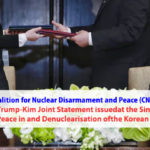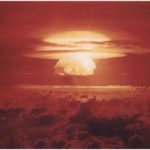Donald Trump announced after Tuesday’s Singapore summit with Kim Jong Un that the North Korean leader had signed an “unwavering commitment to complete denuclearization of the Korean peninsula.” However, the U.S. president warned that “scientifically, [denuclearization] takes a long time.”
John Mecklin, editor of the “Bulletin of the Atomic Scientists,” spoke with Reuters’ Arlene Getz about the science of the process and other implications of the Trump-Kim agreement.
QUESTION: From a scientific perspective, what exactly is involved in dismantling a nuclear arsenal?
MECKLIN: Any nuclear weapons program includes three general areas: the fissile and other material needed to make bombs; the weaponization of that material; and the delivery systems for any nuclear weapons that are created. So-called “complete” denuclearization would involve erasing North Korea’s abilities in all three of those areas, in a verifiable way.
This would be both complicated and difficult. For fissile and other material, this would require rendering any nuclear reactors that can produce plutonium inoperative, eliminating the facilities involved in enriching uranium to bomb grade, and shutting down the processes by which North Korea obtains fuel for hydrogen bombs.
To end weaponization, North Korea would have to give up an array of computers, explosives, detonators, machining capabilities, assembly facilities, nuclear testing installations and other equipment and facilities used in the design, construction, and testing of nuclear warheads. Nuclear weapons can be delivered in many ways, but the United States is primarily worried about North Korea’s ability to launch nuclear warheads on medium- and long-range missiles, which the North would have to give up under any complete denuclearization program.
QUESTION: Trump said in his press briefing after the summit that this could take 15 years. Is that a reasonable time frame?
MECKLIN: Yes. Siegfried Hecker, a top nuclear weapons and North Korea expert at Stanford University’s Center for International Security and Cooperation and a former director of the Los Alamos National Laboratory, has said that a reasonable timetable for the phaseout of the North Korean nuclear program could extend to 15 years.
One of the world’s most respected authorities on nuclear proliferation and weapons programs, Hecker bases his timetable on a report he and fellow experts have published, “A technically-informed roadmap for North Korea’s denuclearization.”
This roadmap suggests that a less-than-complete but carefully thought out denuclearization plan would likely take at least 10 years. Anyone interested in the details behind this roadmap should read the full study on which it is based: “A Comprehensive History of North Korea’s Nuclear Program.” (A video in which Hecker discusses his roadmap as the Singapore summit was under way can be watched here.)
QUESTION: Trump did say that there would be an earlier date of no return for North Korea in the process – “a point at which,” he said, “when you’re 20 percent through, you can’t go back.”
MECKLIN: I try hard not to venture guesses as to what President Trump might be thinking.
QUESTION: What about the other steps taken by Pyongyang that have been hailed as a show of Kim’s good faith: the promise to stop further nuclear tests, the blowing up of tunnels at the Punggye-ri nuclear site and Trump’s statement in Singapore that Kim had said that North Korea was already destroying “a major missile engine testing site? How important are those?
MECKLIN: Destroying the tunnels at that nuclear test site does not of course make nuclear testing impossible. If it were deemed necessary, testing could be done elsewhere, in other tunnels or, if Kim were looking to “impress,” even above ground, over the ocean.
I honestly do not know the North Korean motive for destroying the tunnels at the test site. The experts I have spoken with suggest that an interregnum in testing has little long-term meaning; the North Koreans have proven they know how to build successful fission and (at least) boosted weapons. In theory, other portions of their nuclear program could proceed in the absence of nuclear tests for some period of time.
Most experts with whom I have spoken believe that North Korea committed to almost nothing specific at the Singapore summit, and the vague aspirations in the joint statement issued at summit’s end are just that – vague aspirations that mean little, until and unless a rigorous, step-by-step agreement on the details of denuclearization can be reached. Negotiations toward such an agreement have scarcely started, and what happened Tuesday was more public theater than arms control negotiation.
QUESTION: Assuming North Korea does eventually set a timetable for starting the denuclearization process and agreeing to be monitored by international inspectors, how easy would it be to conceal weapons?
One such framework was created for Iran, via the Joint Comprehensive Plan of Action, or Iran nuclear deal. North Korea is a different country than Iran, and Pyongyang’s nuclear weapons program is much larger and farther along in development than was Iran’s. Any detailed denuclearization plan for North Korea would have to take those differences into account.
ABOUT THE AUTHOR
Arlene Getz is Editor in Charge, Reuters Commentary. Prior to joining Reuters, she was an editor, reporter and foreign correspondent for publications including Newsweek and the Sydney Morning Herald. @arlenegetz
The views expressed in this article are not those of Reuters News.
Source: Reuters News


